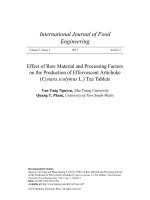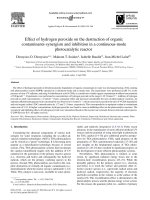The effect of joint thickness and other factors on the compressive strength of brickwork
Bạn đang xem bản rút gọn của tài liệu. Xem và tải ngay bản đầy đủ của tài liệu tại đây (3.62 MB, 7 trang )
5.-The Effect of Joint Thickness and Other Factors on the
Compressive Strength of 8rickwork
by A. J.
FRANCIS,
C. B.
HORMAN
and L. E.
JERREMS
University o[ Melbourne
ABSTRACT
A mechanism for the compressive
failure of brickwork is developed
quantitatively, and is shown to be
capable of explaining the infiuence
that certain variables have on the
compressive strength. lt is shown
experimental/y and theoretically that
the strength of four-brick prisms
declines as the joint thickness increases
and as the lateral tensile strength of
the bricks diminishes in relation to
their compressive strength. The e./fect
of other well-known parameters is
explained in quantitative terms.
b
b
d
e
m
x,y, z
E
P
=
L'Effet de l'Epaisseur des Joints et
d'Autres Facteurs sur la Résistance
à la Compression de la Maçonnerie
en Briques
Un mécanisme pour la rupture à la
compression de la maçonnerie en
brique est développé de façon quantitative, et on montre qu'il est capable
d'expliquer l'inf/uence qu'exercent
certaines variables sur la résistance à
la compression. II est montré de
façon expérimentale et théorique que
la résistance de prismes de quatre
briques décroit avec I'augmentation
de I' épaisseur du joint et à mesure que
la résistance à la traction latérale
des briques diminue par rapport à
leur résistance à la compression.
L'effet d'autres parametres bien
connus est expliqué de façon quantitative.
has been made, with partial success, to describe in quantitative terms the mechanism of the process of compressive
failure. The present paper contains an account of a
simple theoretical model, and some experimental work
on the effect of bed joint thickness in four-high stackbonded prisms which appears to support the theory
put forward. The model also explains a number of the
features of the compressive failure of brickwork.
NOTATION
width of brick
(as suffix) brick
length of brick
strain
(as suffix) mortar
axes of reference
modulus of elasticity
load
tb/tm
Eb/Em
1.2 Model of Compressive Failure of a Short Stackbonded Prism
If a short prism of bricks bonded with mortar (Figure 1
(a» is loaded in axial compression in a testing machine
the mortar joints above and below a brick sufficiently
remo te from the restraining influence of the platens of the
testing machine tend to expand laterally more than the
brick itself, since the modulus of elasticity of the mortar
is normally much lower than that of the bricks. Because
of the mortar-brick bond and the frictional resistance
to slip between the bricks and mortar at the interfaces,
slip will not occur at the interfaces. Lateral tension is,
therefore, induced in the brick, and lateral compression
in the mortar. Vertical splitting, due evidently to lateral
tension, is usually present in a compressive failure of brick
walling.
The criterion of failure of a brittle material like brick
under a condition of vertical compression plus biaxial
lateral tension is not known, but failure will certainly
occur at a lower compressive stress than would be required
in the absence of lateral tension, or if the lateral stresses
were compressive.
The prism shown in Figure l(a) is subjected to an
axial compressive stress a y • The lateral stresses induced
a'ulr/a'r
'I
Poisson's ratio
p
Gulr/a'u/t
a
stress
compressive stress to cause failure of brick
in absence of lateral tensile stress
compressive stress to cause failure of brick
in presence of lateral tensile stress
lateral tensile strength
(1' ult
a'r
EinflujJ der Fugendicke und anderer
Factoren auf die Druckfestigkeit von
Ziegelmauerwerk
Ein Zerstorungsmechanismus von
Ziegelmauerwerk unter Drucklast
ist quantitativ entwickelt worden. Es
wird gezeigt, wie er sich zur Erkliirung
des Einf/usses verschiedener Grossen
auf die Druckfestigkeit eignet.
ExperimenteI! und theoretisch ist
bewiesen, da.fJ die Festigkeit von
Prismen aus je vier Ziegeln mit
grosser
werdender
Fugendicke
abnimmt und da.fJ die seitliche
Zugfestigkeit der Ziegel im selben
Verhii/tnis wie ihre Druckfestigkeit
geringer wird. Die Wirkung anderer
gut bekannter P��������������������������������������������������������������������������������������������������������������������������������������������������������������������������������������������������������������������������������������������������������������������������������������������������������������������������������������������������������������������������������������������������������������������������������������������������������������������������������������������������������������������������������������������������������������������������������������������������������������������������������������������������������������������������������������������������������������������������������������������������������������������������������������������������������������������������������������������������������������������������������������������������������������������������������������������������������������������������������������������������������������������������������������������������������������������������������������������������������������������������������������������������������������������������������������������������������������������������������������������������������������������������������������������������������������������������������������������������������������������������������������������������������������������������������������������������������������������������������������������������������������������������������������������������������������������������������������������������������������������������������������������������������������������������������������������������������������������������������������������������������������������������������������������������������������������������������������������������������������������������������������������������������������������������������������������������������������������������������������������������������������������������������������������������������������������������������������������������������������������������������������������������������������������������������������������������������������������������������������������������������������������������������������������������������������������������������������������������������������������������������������������������������������������������������������������������������������������������������������������������������������������������������������������������������������������������������������������������������������������������������������������������������������������������������������������������������������������������������������������������������������������������������������������������������������������������������������������������������������������������������������������������������������������������������������������������������������������������������������������������������������������������������������������������������������������������������������������������������������������������������������������������������������������������������������������������������������������������������������������������������������������������������������������������������������������������������������������������������������������������������������������������������������������������������������������������������������������������������������������������������������������������������������������������������������������������������������������������������������������������������������������������������������������������������������������������������������������������������������������������������������������������������������������������������������������������������������������������������������������������������������������������������������������������������������������������������������������������������������������������������������������������������������������������������������������������������������������������������������������������������������������������������������������������������������������������������������������������������������������������������������������������������������������������������������������������������������������������������������������������������������������������������������������������������������������������������������������������������������������������������������������������������������������������������������������������������������������������������������������������������������������������������������������������������������������������������������������������������������������������������������������������������������������������������������������������������������������������������������������������������������������������������������������������������������������������������������������������������������������������������������������������������������������������������������������������������������������������������������������������������������������������������������������������������������������������������������������������������������������������������������������������������������������������������������������������������������������������������������������������������������������������������������������������������������������������������������������������������������������������������������������������������������������������������������������������������������������������������������������������������������������������������������������������������������������������������������������������������������������������������������������������������������������������������������������������������������������������������������������������������������������������������������������������������������������������������������������������������������������������������������������������������������������������������������������������������������������������������������������������������������������������������������������������������������������������������������������������������������������������������������������������������������������������������������������������������������������������������������������������������������������������������������������������������������������������������������������������������������������������������������������������������������������������������������������������������������������������������������������������������������������������������������������������������������������������������������������������������������������������������������������������������������������������������������������������������������������������������������������������������������������������������������������������������������������������������������������������������������������������������������������������������������������������������������������������������������������������������������������������������������������������������������������������������������������������������������������������������������������������������������������������������������������������������������������������������������������������������������������������������������������������������������������������������������������������������������������������������������������������������������������������������������������������������������������������������������������������������������������������������������������������������������������������������������������������������������������������������������������������������������������������������������������������������������������������������������������������������������������������������������������������������������������������������������������������������������������������������������������������������������������������������������������������������������������������������������������������������������������������������������������������������������������������������������������������������������������������������������������������������������������������������������������������������������������������������������������������������������������������������������������������������������������������������������������������������������������������������������������������������������������������������64
-
-
-
-
{
308
fl 277
0·38
3030
4720*
OAO
3080
5660*
0·67
2300
22401'
0·63
2660
2050t
0·65
2450
1840t
0·64
O
4220
0·67
2980
0·02
3950
0·62
3180
0·05
4600
0·68
2570
0·02
4020
1 ·00
2130
OA2
2920
1·00
2290
0·41
3150
1·00
2190
OAO
2890
1·00
2020
0,41
2810
zero (dry)
9·8
16·5
Modulus of
elasticity Eb (lbf;in 2)
3·8 x IG6
2·95 X 106
Poisson's ratio
0·25
0·25
Vb
4070*
by volume). 1·25 parts of water, also by volume, were
added, after trial mixes for workability.
The compressive strength, obtained on mortar cubes
accordi ng to AS A123 , was as follows :
Mean sfrengfh
Coeff. of
(lbf/in 2 )
variation
( %)
927
8·6
Other mean values used were:
Em 0·20 X 106 1bf/in 2
Vm
0·25*
I
3120
• Polished faces .
Masonry saw-cut faces.
t
TABLE
3B-
PRISM
CO:\1PRESSIVE
STRENGT HS
(aul,):
PERFORATEO
BRIC KS
2.2.4 Four-Brick Prisms
In each type of brick, six prisms were made with mortar
joints approximately either 0 ·4-in. or 0 ·6-in . thick, and
four prisms of each brick type with l-in.-thick joints,
including in each case layers of mortal' of the same
thickness at top and bottom of each prism .
Four prisms of each brick type were also made with as
fhin joints as possible. The prisms were cured in air in
the laboratory and tested in a Denison 200-ton compression testing machine between cardboard sheets at the
age of 14 days.
On a number of the prisms, longitudinal and transverse
strains were measured with a 2-in . Demec gauge. The
values of Eb, Vb and Em quoted above and in Table 2
were determined from these measurements, the latter
from measurements across the joints.
Three solid brick prisms and two perforated brick
prisms were also prepared and tested dry. In these the
contacting surfaces of the bricks were polished in a
geological polishing machine until they were plane to a
high degree of accuracy. Four piers with solid bricks
and three with perforated bricks, whose upper and lower
faces had been trimmed fiat with a masonry saw, were
also tested dry. The frogs in the solid bricks were filled
* Value supplied by Division of Building Resean;h. CSIRO,
Melbourne.
Average
joint
thickness
(in .)
au ll
(lbfl in 2 )
I
I
Average
joint
Ihickness
(in.)
aul,
(lbf/in 2)
0·31
2460
0·33
2440
0·31
2810
3940t
0·54
2305
3930t
0·57
2213
3990t
0'56
1780
O
5450
0·57
2530
O
5770
0·53
2305
0·02
5475
0·55
2420
0·04
4450
1·00
1128
0·35
2970
1·00
1255
5430*
8760*
zero (dry)
3810t
I
0·32
I
2625
J ·00
1255
0·35
II
I
2750
\·00
123\
* Polished faces .
t Masonry saw-cut faces.
A. J. Francis, C. B. Horman and L. E. Jerrems
spa lling of brick faces. The solid bricks were obviously
less brittle.
One of the dry piers with polished contacting faces
(perforated brick) developed the remarkably high strength
of 9760Ibf/in 2, failing with explosive force. The dry
piers with saw-cut contacting surfaces, however, were
much weaker, and it was noticed that slight cracking
and spalling began under very low stresses (of the order
of 300 Ibf/in 2 in some cases). This was probably caused
by uneven bearing between the dry surfaces, which
indicates the important part played by the mortar
joints in reducing or eliminating these stress concentrations, as had been demonstrated by WEST and others. 3
The compressive strengths of the prisms are plotted
against the mean joint thickness in Figures 6 and 7.
So l id
Four
Br ic" Pr i sms
Bricks H igh
PQrforotQd
35
Br ick Prisms
Four Br i c" s HI9h
t
760 I bf/ i n'
60
""
Q
":'--O~II' 5 600 Jbf/i n'
o Dr y Pr i sms ; Po li shQd FOCQS
• Dry Pr i 5ms , Mosonry SowCul Foces
o
o
-
Vori ous Jo i nl Th ick ness.s
A verogQ CurvQ
b" 4
o
'">
o
:::
00
::'a.
E 20
8
o
Dr y Pr isms , Pol i shQd FOCQS
o
Dry Prismsí Mosonry So",Cul FO CQS
V orious Jo i nl Thi cknesses
•
o
--- Averog. Curve
O
Av.roge Jo inl Th ickn.ss , Im [in]
FIGURE 7- Variation of prism compressive strength with morta r
joint thickness- solid bricks.
TABLE 4-PARAMETER VALUES
o
0 2
04
AvorogQ Joinl Thi cknQss , trJl
0 8
10
Paramefer
Solid bricks
Per/orafed
bricks
'"
2·91
---Im
2·98
----
fi
1m
3-80 = 19.0 2'95 = 14 '75
0·20
0 ·20
Qn]
FIGURE 6-Variation of prism compressive strength with mortar
joint thickness- solid bricks.
lt was hoped to obtain a 'ull from the tests on the
prisms with dry joints, but it was obvious that the
strengths of these prisms depended very much on the
degree of planeness of the contacting surfaces; furthermore, the values bore no consistent relation to the trend
of the results for various joint thicknesses. A mean line
was drawn, therefore, through the results for the prisms
for each brick type with mortar joints and the values at
zero joint thickness taken as a'u/t: these were 4150 and
5600 Ibf/in 2 for solid and perforated bricks respectively.
With the values of E, 'I, a't, etc. given earlier, eqn. (12)
can be plotted for the two types of brick. The values
of the relevant parameters are given in Table 4.
The theoretical and experimental values of p( = ao/t/ a 'u/t)
are shown in Figure 8.
The most striking aspect of these results is the effect
of joint thickness on the strength of the prisms. This
phenomenon has been observed before in the Iiterature. 4
Obviously, the thinner the joints the stronger the
brickwork, and this is the reason for the requirement in
the SAA Brickwork Code that in structural brickwork
(i.e. brickwork requiring engineering design to the
'"
4150 = 11040 5600= 18'80
364
298
requirements of the Code) the joints must not be more
than 1--in. thick, and shall preferably not exceed i in.
in thickness. (The ancient Egyptian, Greek and Roman
engineers, in whose stone temples, aqueducts, and other
major structures the joints are usually extremely thin,
often with no morta r at all, evidently had an intuitive
sense of good practice in masonry construction.)
Another interesting aspect of the results is the greater
loss of strength with increase in joint thickness for the
perforated bricks compared with the solid bricks. It
seems certain that a major cause of this is the lower
ratio of </>, i.e. the greater weakness in lateral tensile
strength in the perforated bricks caused by the presence
of the holes. The theory indicates a less pronounced
difference between the performance of the two types of
brick than was found experimentally.
The reason for this discrepancy probably lies in the
method of estimating the lateral tensile strength, which
is admittedly crude and probably only gives a rough
approximation to the true value of this parameter.
36 The Effect of Joint Thickness and Other Factors on the Compressive Strength of Brickwork
or thicker waIling to have a lower compressive strength
than 4t -in. walling, because of the presence of vertical
joints in both directions. This is again confirmed by
experiment: Swiss results quoted by MONK5 are given
below.
12
•
[12J
•
501 i d
o
PQrfor"o\Qd Bricks
Wal/ construction
So li d Bricks
••
Q
Bricks
•
I
•
0"4
0 2
02
0 "4
06
0 8
10
AV Qrog Q Joint Th i ck n Qss , tm [i n]
FIGURE
Relative
strength
(in.)
Single brick width
Single brick width
Single brick width
Multiple brick width
00
o
Wall
thickness
8- Variation of p with joint thickness: theoretical and
experimental resu lts compared.
Further, the fail ure criterion adopted in the theory
is only conjecturaI. The value used in eqn. (12) for
Poisson 's ratio of the mortar also has an important
bearing on the result. The figure ofO ·25 was not measured
but was suggested by the Division of Building Research
CSIRO, Melbourne.
3. FURTHER DISCUSSION OF THE MECHANISM
OF COMPRESSIVE FAILURE
On the basis of the model proposed above, other observed
phenomena associated with the compressive strength
of brickwork can be explained.
3.1 Strength of Short 4t -in. WalIs
The presence of vertical joints, which have a much lower
lateral tensile strength than even the bricks, may be
expected to reduce further the compressive strength
under axial load, and the greater their frequency in the
brickwork, the lower should be the compressive strength.
Thus we would expect the four-high prisms used in the
present investigation, and standard brickwork compressive strength specimens in the SAA Code, to be
stronger than 4t-in. walling of small slenderness ratio.
This is in agreement with experimental results, and Rule
6.7.1.5 in the Code requires that the basic strength of
brickwork (F'm) for the purposes of establishing design
stresses is to be taken as 0 ·75 of the minimum prism
strength.
If an average bond strength of 60 Ibf/in 2 is assumed at
the vertical joints, then since a tensile crack will pass
through joint and brick in alternate courses the mean
value of a' l for the solid bricks in this study would be
(364 + 60)/2 = 212Ibf/in 2 . Eqn. (J 2) then yields a value for
the strength of 4t-in. walling which is in reasonable
agreement with the test results given by FRANCIS.4
3.2 Strength of Short 9-in. WalIs
Continuing the above reasoning, we should expect 9 in.
5
6
7- 10
10- 15
1·00
0 ·89
0 "80
0·68
Account is taken ofthis in the Swiss regulations governing structural masonry.6
3.3 Brick and Mortar Properties
The theory indicates that the strength of brickwork
should increase with the compressive strength of the
bricks, and with increase in the compressive strength
(and therefore in the modulus of elasticity) of the
mortar. These two effects are well known and allowed
for in all modem codes dealing with the form of construction. Poor lateral tensile strength in the bricks
compared with their compressive strength is known to
have a deleterious effect on the strength of brickwork,
not only from the work reported in this paper but also
from the extensive test programme recently conducted
on storey-height walls by the British Ceramic Research
Association,7 and from tests on storey-height walls
and on wallettes for the Brick Development Research
Institute. 8 Provision for this effect has not been made
in codes in the past, but it may be desirable to place some
limit on the reduction in cross-sectional area of perforated
bricks to be used in highly stressed construction.
3.4 Bond Strength
Since the lateral strength or vertical joints depends
mainly on the bond strength between bricks and mortar,
it is obvious that the axial compressive strength of
brickwork must be improved if good bond strength
is achieved. Bond strength is of COLme, of paramount
importance wherever bending or eccentricity of load
causes tensile stresses.
3.5 Joint Reinforcement
Steel reinforcement placed in the bed joints, even if
only light-gauge, will substantially increase the compressive strength of the mortar and particularly the effective
value of Em and the Poisson's ratio of the jointing.
Tests by HENDRy9 showed that the compressive strength
of 4t -in . storey-height walls was increased by over 60 %
when every course was reinforced with a patent woven
mesh, but that if only every fifth COLme was reinforced
there was no strengthening effect.
4. CONCLUSIONS
The mechanism of compressive failure developed in this
paper certainly does not take account of all the relevant
factors of importance, but it is a start in the right direction.
It appears to be capable of explaining a number of
well-known but apparently unconnected phenomena
associated with the behaviour of brickwork in compression, in particular the effect of the thickness of
joints and of the lateral tensile strength of the bricks.
A. J. Francis, C. B. Horman and L. E. Jerrems
ACKNOWLEDGEMENTS
Thanks are due to Mr 1. C. McDowall, formerly Director,
Brick Development Research Institute, Melbourne for
help with the project, and to Mr C. Tonta for assistance
in the testing.
REFERENCES
1. BRADSHAW, R. E ., Structural Ceramics. Conference on Industrial
Building and the Structural Engineer. Inst. Str. Eng., 1966.
2. HILSDORF, H. K., Investigation into the Failure Mechanism of
Brick Masonry Loaded in Axial Compression. ' Designing,
Engineering and Construction with Masonry Products.'
Edited by F . B. Johnson. Houston, Texas, Gulf Publishing,
1969. pp. 34-41.
3. WEST, H. W . H. , EVERILL, J. B. and BEECH, D. G ., The Testing
of Bricks and B10cks for Load-bearing Brickwork. Proc.
X Int. Ceram. Congr., Stockholm, 1966. pp. 559- 565 .
37
4. FRANCIS, A. J., The S.A .A. Brickwork Code: The Research
Background . Inst. Engrs. Aust. , Civil Eng. Trans., October
1969. pp. 165-176.
5. MONK, C. B. Jr., Old and New Research on Clay Masonry
Bearing Walls. 1st Nat. Brick and Tile Bearing Walls Conf.,
Pittsburgh (May, 1965).
6. SCHWEIZERISCHER INGENIEUR UND ARCHITEKTEN, Technical Note
No. 113. Verein, SIA, Oct. 1963.
7. WEST, H . W. H ., HODGKINSON, H. R. and DAVENPORT, S.T.E.,
The Performance of Walls Built of Wire-cut Bricks with
and Without Perforations. Trans. Brit. Ceram. SOCo 67,
(10) , 434, 1968.
8. McDoWALL, L c., McNEILLY, T . H. and RYAN, W. G., The
Strength of Brick Walls and Wal1ettes. Special Rpt. No. I,
Brick Development Research Ins!., Melbourne, Nov. 1966.
9. PRASAN, S., HENDRY, A. W. and BRADSHAW, R. E. Crushing
Tests on Storey-height Wal1s 4·Hn. Thick. Proc. Brit.
Ceram . Soe. (4), 67, 1965.









